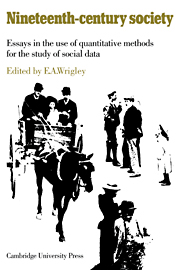Book contents
- Frontmatter
- Contributors
- Contents
- Introduction
- 1 The census, 1801–1891
- 2 The study of family structure
- 3 Sources of inaccuracy in the 1851 and 1861 censuses
- 4 Standard tabulation procedures for the census enumerators' books 1851–1891
- 5 Sampling in historical research
- 6 The use of information about occupation
- 7 The use of published census data in migration studies
- 8 Criminal statistics and their interpretation
- 9 The incidence of education in mid-century
- Notes
- Bibliography
- Index
3 - Sources of inaccuracy in the 1851 and 1861 censuses
Published online by Cambridge University Press: 05 November 2011
- Frontmatter
- Contributors
- Contents
- Introduction
- 1 The census, 1801–1891
- 2 The study of family structure
- 3 Sources of inaccuracy in the 1851 and 1861 censuses
- 4 Standard tabulation procedures for the census enumerators' books 1851–1891
- 5 Sampling in historical research
- 6 The use of information about occupation
- 7 The use of published census data in migration studies
- 8 Criminal statistics and their interpretation
- 9 The incidence of education in mid-century
- Notes
- Bibliography
- Index
Summary
The exploitation of the enumerators' returns to the nineteenth-century censuses, whether by using computers, mechanical data-processing machinery, or simply many hands to make light of the work, has in the past few years begun to reach sizeable proportions. Some indication of the quantity of work in hand may be found within the covers of the present book. It seems appropriate, therefore, to try to assess the quality of the returns as source material with particular reference to the way in which they were compiled.
The following commentary is derived from experience gained while investigating the social and economic history of various urban and rural communities in Yorkshire and Lincolnshire and adjacent counties with a combined total population of more than 50,000. The method of analysis adopted was designed to investigate the total population of each community rather than a sample, so nearly 3,000 pages of enumerators' books (recording a population of about 56,000 persons) have been examined. Most of this work was on the 1851 returns; such comparative study as has been possible with those for 1861 suggests that while similar experience with them would be very desirable, much of the commentary applies equally to both censuses. Yet, while it may fairly be claimed that the work is numerically widely based, it is limited to a few areas. The returns for other parts of England, particularly for London, may exhibit variations in practice that go altogether unmentioned here; and the returns for Wales, Scotland, and Ireland do not yet seem to have been examined from this point of view.
- Type
- Chapter
- Information
- Nineteenth Century Society , pp. 82 - 133Publisher: Cambridge University PressPrint publication year: 1972
- 8
- Cited by



